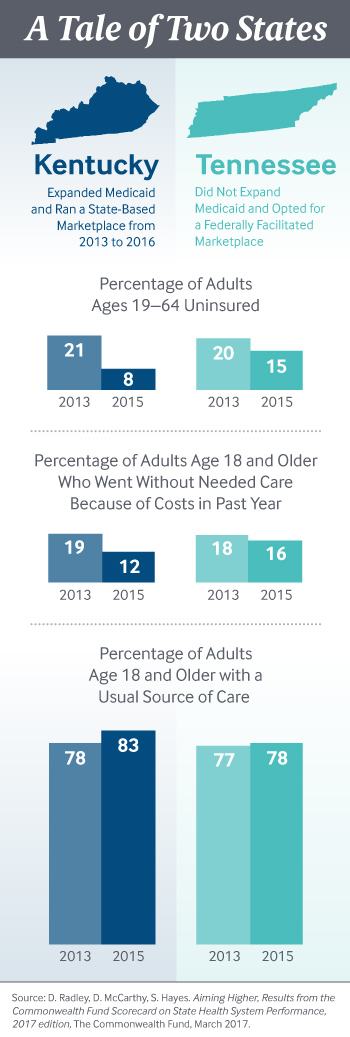As the future of the Affordable Care Act (ACA) has been debated, questions have been raised about the value of the law’s health insurance coverage expansions, and Medicaid in particular. To explore whether the ACA improved access to care, we used data from The Commonwealth Fund’s just-released Scorecard on State Health System Performance, 2017 to examine people’s experiences in Kentucky, a state that expanded Medicaid eligibility as soon as federal resources became available in January 2014, and ran its own health insurance marketplace from 2013 to 2016. We also compared Kentucky’s performance to that of its neighbor, Tennessee.
Kentucky and Tennessee don’t just share a border; they are also similar in size, population demographics, and geography. And prior to the ACA’s coverage expansions, the two had similar rates on the Scorecard’s coverage and access measures. But they took very different approaches to the ACA: Unlike Kentucky, Tennessee chose not to expand Medicaid eligibility, and opted to let its residents use the federal marketplace. Kentucky, on the other hand, invested in aggressive outreach efforts and enrollment assistance to inform residents of their coverage options and help them enroll.

In 2013, the year before the ACA’s major coverage expansions took effect, in both Kentucky and Tennessee, about one of five working-age adults lacked health insurance. But just two years later, Kentucky’s adult uninsured rate had dropped 13 percentage points, from 21 percent to 8 percent, while Tennessee’s rate had declined by only five points (from 20% to 15%).
The difference was even more dramatic among adults with incomes below 200 percent of the federal poverty level (or $23,540 a year for a single person), who were most likely to benefit from Medicaid expansion and the financial assistance available through the marketplace. In 2013, in both states, nearly two of five low-income working-age adults lacked health insurance. By 2015, the rate of uninsured low-income adults in Kentucky had plummeted 25 percentage points, from 38 percent to 13 percent. In Tennessee, the rate dropped nine points (from 37% to 28%), but more than a quarter of low-income adults in Tennessee remained uninsured.
Not only did more Kentuckians have health insurance cards by 2015, but more received care they needed. Between 2013 and 2015, Kentucky experienced the largest drop—seven percentage points—of any state in the share of adults who reported not going to the doctor when they needed to because of costs, declining from 19 percent to 12 percent. This decline was three-and-a-half times the decrease seen in Tennessee for this measure. Again, improvements were most striking among low-income people: Kentucky had a double-digit reduction in the share of low-income adults who reported forgoing needed care because of costs. In Tennessee, the decline was two points among this group.
Another key measure of access is having a regular doctor or health care provider, which is also linked to greater receipt of preventive care, improved health outcomes, and lower costs. In 2013, slightly more than three-quarters of adults in Kentucky and in Tennessee reported having a usual source of care. Two years later, the rate in Kentucky had improved by five points, from 78 percent to 83 percent, while Tennessee showed little improvement, only a one-point gain, from 77 percent to 78 percent.
Our findings are consistent with the results of a study conducted by Benjamin Sommers and colleagues at Harvard University with support from The Commonwealth Fund that compared changes in coverage and access to care between 2013 and 2015 among low-income adults in Kentucky and in Texas, which like Tennessee did not expand Medicaid.1 These researchers found that by the end of 2015, low-income adults in Kentucky were more likely than those in Texas to have health insurance coverage and to have reductions in cost-related barriers to care and increases in receipt of preventive care and care for chronic conditions.2
Taken together, these findings suggest that, despite claims to the contrary, the ACA has led to improved access to and receipt of care in Kentucky.
Notes
1 B. D. Sommers, R. J. Blendon, E. J. Orav et al., “Changes in Utilization and Health Among Low-Income Adults After Medicaid Expansion or Expanded Private Insurance,” JAMA Internal Medicine, published online Aug. 8, 2016; and R. Gourevitch and B. D. Sommers, "Medicaid Expansion in Kentucky: Early Successes, Future Uncertainty," To the Point, The Commonwealth Fund, July 8, 2016.
2 Ibid.



